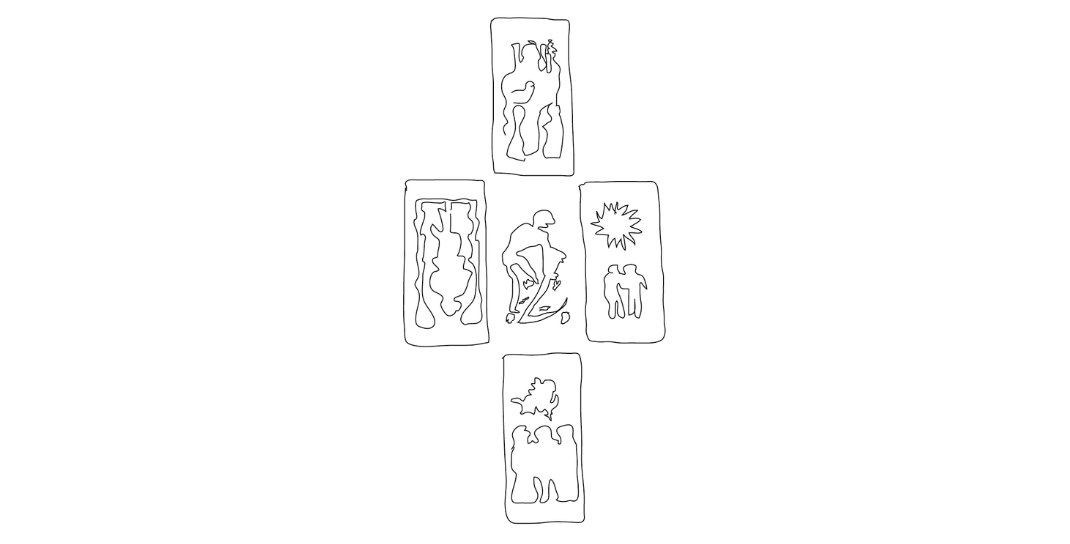Night of Queens 2024 Simbologism
12 Jan 2024

When
12th of January 2024Who
Chiquita RoomCategory
SimbologismShare
What values can help us to approach this new year? Once again, in Chiquita Room, we let ourselves be guided by the tarot with the interpretation of Susanna, Saya and Cecilia.
As an introduction, Saya proceeds to analyse the numerology of the new year 2024, whose sum of the numbers equals 8. The number 8 augurs a karmic year, in which we will have to face our own decisions and our own actions, through what we sowed the previous year and we will be reaping.
Next: the spread in the form of a cross, made up of the thesis (the yes), the antithesis (the no), the synthesis, the concluding card and, in the centre, the major card as a guide card. From collectively chosen numbers, you get the cards of The Hanged Man, The Sun, The Pope, The Lover and Death.
Starting with the thesis, The Hanged Man is revealed. This card represents inaction as, as Saya explains, he has his hands hidden behind his back and is hanging by one foot from a tree. This is sometimes the best action we can take. It invites us to look at our surroundings from a different perspective, to listen and not to rush. At the same time, it gives us a glimpse of a blockage, an uncomfortable position that slows down our evolution.
The Hanged Man is represented by the number 12. Complementary to the analysis of the number 8, it is the culmination of a cycle. It illuminates a cathartic situation that allows us to give way to new cycles, thus moving us away from our comfort zone that allows us to connect with our intimate truth.
On the other hand, opposite to the Hanged Man, the Sun appears as an antithesis. It is a peculiar chart, as it is very positive in itself. However, this position tells us that we have not yet chosen the light or taken the initiative, as we are waiting for someone to let us off the hook. It is also possible that the blocking situation of the previous chart is because of the Sun, as we do not have enough clarity.
In the synthesis, we have the card of The Pope, the masculine archetype of an all-powerful being on Earth. His primary action is that of an immaterial messenger. In this particular spread, he gives us the idea of looking for a reference, a guide, to undo inaction. We may need to look for a connection to the divine, to the spiritual, or even to ourselves. However, it warns us not to fall into idolatry or to put the responsibility outside ourselves.
The Lover appears in the place of the conclusion. This card, related to the Pope, represents the mastery or choice that connects us to our true self. It is a path that leads us to connect with what we truly desire, after having attained a higher knowledge. In essence, it is about choosing ourselves as our first choice and surrendering to it out of our deepest love.
In short, on a collective, political and social level, we are misguided, there is little clarity and, politically, there is talk of polarities. In spite of this, we have the great power to choose what we want and to bet on our real action with our heart and not with our mind, because of what the family or the environment tells us to do. This spread, in general, confronts us with some kind of dilemma that blocks us out of fear and insecurities, and puts us in a position where we have to avoid the comfort of what we already know.
Finally, the presentation of the Death card in the centre of the spread once again highlights “the harvest”. Death symbolises transformation, it is the nameless card and invites us to shed our identity to be reborn from the ashes. To do so, we must assume the consequences of our own death, no longer remaining in the warm and comfortable limbo of the Sun. Even if our decisions have no guarantee of success, we must free ourselves from what does not serve us. Experiencing change is a process of darkness and fear, but it also involves glimpsing the light at the end of the tunnel.
In conclusion, it is a year of uncertainty, of harvest, of discoveries and surprises that will make us give up and lose. It will involve an inevitable transformation of everything we know and even of ourselves. The material will no longer serve, for action will have to emerge from another immaterial place. The choice is the death of the disguise, of what we had built to survive the world, thus ceasing to be subject to beliefs, to the external and the established.
What is transformative, and where a lot of light enters, is when we choose from our own beliefs. The invitation is not to resist transformation and to remember that we always have the option to choose.


